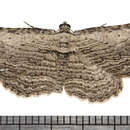Distribution
provided by University of Alberta Museums
Widespread throughout much of temperate North America. In Alberta it has been collected mainly in the parklands and montane areas, less commonly in wooded riparian areas in the grasslands and in the northern boreal forest.
- license
- cc-by-nc
- copyright
- University of Alberta Museums
General Description
provided by University of Alberta Museums
One can do no better than quoting Lynn Scott's description of this otherwise rather drab creature: “Both the forewings and the hindwings of Horisme intestinata are largely covered with fine, gray-brown, parallel, crosswise lines, which are aligned at rest so that the moth somewhat resembles a smear of something on my brick wall. The ground color of the wings is a pale yellowish brown or tan, slightly darker towards the outer margins. The upper third of the forewing is less striped, with a plain area around the small discal dot. The deep scallops of the postmedial line are quite evident when one takes a close look, but on a quick glance, the wing simply appears streaky. In the subterminal area, there is a whitish scalloped line on both forewing and hindwing. The darkest markings are the ends of a dark lines at the inner margins of the forewings, which are aligned with a dark line across the base of the abdomen to form a darker mark across the middle of the moth at rest” (Lynn Scott, 2001-2007). Wingspan approx. 2.5-3.2 cm. The related H. incana Swett is a more two-toned light and dark brown and has a sharply defined contrasting yellow-brown stripe along the costa.
- license
- cc-by-nc
- copyright
- University of Alberta Museums
Habitat
provided by University of Alberta Museums
Frequents wooded areas.
- license
- cc-by-nc
- copyright
- University of Alberta Museums
Life Cycle
provided by University of Alberta Museums
Very poorly known. Adults are nocturnal and come to light. The main flight if from late May through late July, peaking in late June. A small second brood appears in early September through early October. The larva is undescribed and the larval hosts are unknown. Larvae of European species feed on Clematis.
- license
- cc-by-nc
- copyright
- University of Alberta Museums
Horisme intestinata: Brief Summary
provided by wikipedia EN
Horisme intestinata, the brown bark carpet moth, is a moth of the family Geometridae. It is widespread throughout most of temperate North America. The habitat consists of wooded areas.
The wingspan is 21–32 mm. The pale tan forewings are marked with fine parallel lines. The PM and ST lines are deeply scalloped. The wide costal streak is almost unmarked. Adults are on wing from late May to late July and again from early September to early October.
The larvae have been recorded feeding on garden Clematis.
- license
- cc-by-sa-3.0
- copyright
- Wikipedia authors and editors

